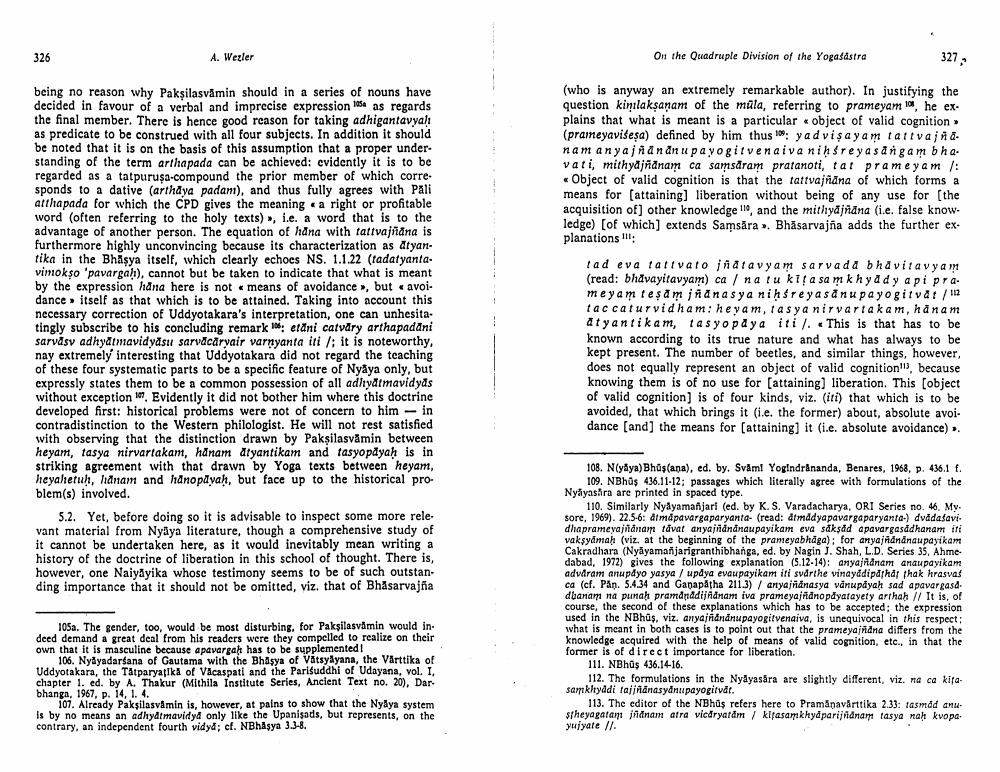________________
326
A. Wezler
On the Quadruple Division of the Yogasastra
327,
(who is anyway an extremely remarkable author). In justifying the question kimilaksanam of the mala, referring to prameyam , he explains that what is meant is a particular object of valid cognition (prameyavišeşa) defined by him thus : yad visayam tatt vaja namanya j Adnanu payogilvenaivanih sreyasangam bhe. vari, mithyajñanam ca samsaram pratanoti, tar prameyam 1:
Object of valid cognition is that the tattvajnana of which forms a means for [attaining) liberation without being of any use for the acquisition of) other knowledge 10, and the mithyajidna (i.e. false know. ledge) (of which) extends Samsāra Bhasarvajña adds the further ex. planations :
being no reason why Paksilasvamin should in a series of nouns have decided in favour of a verbal and imprecise expressione as regards the final member. There is hence good reason for taking adhigantavyah as predicate to be construed with all four subjects. In addition it should be noted that it is on the basis of this assumption that a proper under standing of the term arthapada can be achieved: evidently it is to be regarded as a tatpurusa-compound the prior member of which corre sponds to a dative (arthaya padanı), and thus fully agrees with Pali atthapada for which the CPD gives the meaning a right or profitable word (often referring to the holy texts), i.e. a word that is to the advantage of another person. The equation of hana with tattvajnana is furthermore highly unconvincing because its characterization as atyantika in the Bhişya itself, which clearly echoes NS. 1.1.22 (tadatyantavimokso 'pavargah), cannot but be taken to indicate that what is meant by the expression hana here is not means of avoidance, but avoidance » itself as that which is to be attained. Taking into account this
sary correction of Uddyotakara's interpretation, one can unhesita tingly subscribe to his concluding remark 1 etani catvary arthapadani sarvasv adhyatmavidyasu sarvacaryair varnyanta iri /; it is noteworthy, nay extremely interesting that Uddyotakara did not regard the teaching of these four systematic parts to be a specific feature of Nyaya only, but expressly states them to be a common possession of all adhyatmavidyas without exception 1. Evidently it did not bother him where this doctrine developed first: historical problems were not of concern to him in contradistinction to the Western philologist. He will not rest satisfied with observing that the distinction drawn by Paksilasvămin between heyart, tasya nirvartakam, hanam atyantikam and tasyopayah is in striking agreement with that drawn by Yoga texts between heyam, heyahetuh, hanam and hanopayah, but face up to the historical problem(s) involved.
5.2. Yet, before doing so it is advisable to inspect some more rele vant material from Nyāya literature, though a comprehensive study of it cannot be undertaken here, as it would inevitably mean writing a history of the doctrine of liberation in this school of thought. There is, however, one Naiyayika whose testimony seems to be of such outstanding importance that it should not be omitted, viz. that of Bhasarvajna
tad eva tativato india vyam sarvada bha vita vyam (read: bhavayitavyar) ca natuklasa mkhyad y api pra. meyam teşa minanasya nih sreya sanu payogitvar / 12 taccaturvidham: heyam, tasya nirvartakam, hanam atyantikam, tasyopaya itil. This is that has to be known according to its true nature and what has always to be kept present. The number of beetles, and similar things, however, does not equally represent an object of valid cognition", because knowing them is of no use for [attaining) liberation. This (object of valid cognition) is of four kinds, viz. (ii) that which is to be avoided, that which brings it i.e. the former) about, absolute avoi. dance (and) the means for [attaining) it (l.e. absolute avoidance),
108. Nyaya) Bhus(ana), ed. by. Sväml Yogindrananda, Benares, 1968. p. 436.1 f.
109. NBhQs 436.11-12; passages which literally agree with formulations of the Nyayasira are printed in spaced type.
110. Similarly Nyayamafjarl (ed. by K. S. Varadacharya, ORI Series no. 46. My. sore, 1969). 22.5-6: drmdpavargaparyanta- (read: dmddya pavargaparyanta) dvddašavi. dhapramevajnánar fávat anyajidndnau payikam eva sdksdd a pavargasddharam iti vaksydmah (viz. at the beginning of the prameyabhdga): for anya Adnanaupayika Cakradhara (Nyayamañjarigranthibhanga, ed. by Nagin J. Shah, LD. Series 35. Ahme dabad, 1972) gives the following explanation (5.12-14): anyajAdnam anaupayikam advdram anupdyo yasya / updya evou payikam iti svd the vineyddipdthar thak hrasvas ca (cf. Pån. 5.4.34 and Ganapatha 2113) / artyajidnasya vārupdyah sad a pavargasadhanam na punah pramdnadij Adnam iva prameyaj Adnopdyatayely arthah // It is, of course, the second of these explanations which has to be accepted the expression used in the NBhûs, viz. anyajiandnu payogitvenaiva, is unequivocal in this respect what is meant in both cases is to point out that the prameya Adna differs from the knowledge acquired with the help of means of valid cognition, etc., in that the former is of direct importance for liberation.
111. NBhûs 436.14-16.
112. The formulations in the Nyayasära are slightly different, viz. na ca kirasarkhyddi tajjnanasydnu payogitvdr.
113. The editor of the NBhos refers here to Pramanavarttika 2.33: tasmadamu. stheyagaram jidnam atra vicdryaram / klfasamkhydparijfidan tasya mah kvopo yujyate Il.
105a. The gender, too, would be most disturbing, for Paksilasvamin would indeed demand a great deal from his readers were they compelled to realize on their own that it is masculine because a pavargah has to be supplemented
106. Nydyadariana of Gautama with the Bhasya of Vatsylyana, the Varttika of Uddyotakara, the Tätparyatika of Vacaspati and the Parifuddhi of Udayana, vol. I, chapter 1. ed. by A. Thakur (Mithila Institute Series, Ancient Text no. 20), Dar bhanga, 1967, p. 14, 1. 4.
107. Already Paksilasvamin is, however, at pains to show that the Nyaya system is by no means an adhyatmavidyd only like the Upanişads, but represents, on the contrary, an independent fourth vidyd; cf. NBhasya 3.3-8.




